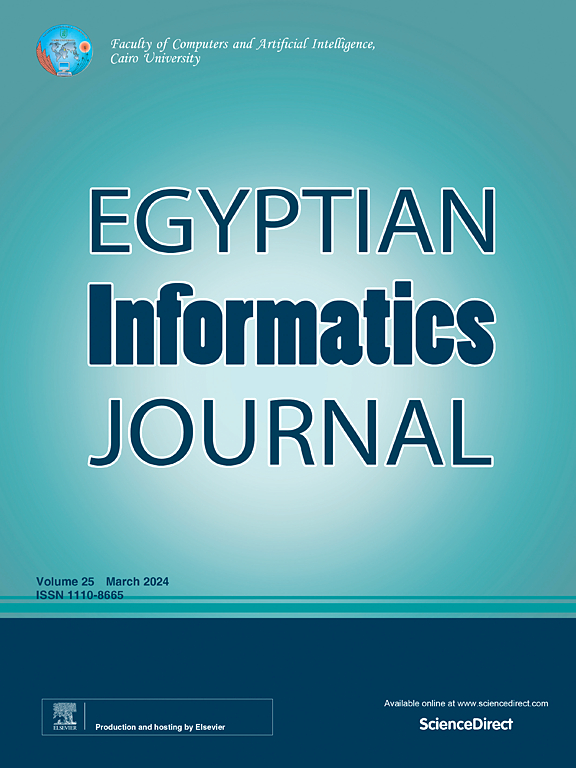Proposed machine learning technique based on RIME algorithm for gas prediction: A case study of the Messinian Abu Madi Reservoir, Nile Delta Basin, Egypt
IF 4.3
3区 计算机科学
Q1 COMPUTER SCIENCE, ARTIFICIAL INTELLIGENCE
引用次数: 0
Abstract
Accurate prediction of hydrocarbon presence in subsurface formations remains an open problem in petroleum exploration, particularly in complicated geology and petrophysical datasets with imbalance. Conventional machine learning algorithms such as the Random Vector Functional Link (RVFL) network have shown promise but are prone to performance sensitivity due to human-based parameter adjustment and the inability to effectively address class imbalance. This study avoids these limitations by proposing an optimization approach based on swarm intelligence that integrates the RIME algorithm and RVFL for better predictability. This study introduces a novel approach utilizing swarm optimization techniques for determining the presence of oil in wells. The method is based on the principles of Swarm Intelligence (SI), a well-known machine learning methodology inspired by the collective behavior of decentralized, self-organized systems. This research particularly harnesses SI for analyzing geological data for the prediction of whether a well contains oil or not. The core of the swarm-based approach lies in its ability to efficiently process vast and complex datasets to identify patterns indicative of oil presence. This is achieved by estimating and predicting the key petrophysical parameters for hydrocarbon reservoirs (e.g., water saturation, total porosity, & shale volume). This swarm-optimized approach benefits from the space-searching capability of the swarm algorithms, leading to more accurate and speedy predictions. Random Vector Functional Link (RVFL) algorithm is used to optimize the selection of relevant geological features and parameters, enhancing the model’s predictive accuracy. RVFL processes well log data to predict gas-bearing intervals, while RIME automates parameter selection (e.g., hidden nodes, activation function), achieving up to 99.1% accuracy on imbalanced datasets. Applied to well log data from the Abu Madi Formation, the hybrid model optimizes key petrophysical parameters (e.g., water saturation, porosity, shale volume), offering superior accuracy, sensitivity, and computational efficiency compared to existing methods like AHA and GWO. This approach represents a significant advancement for hydrocarbon exploration workflows, enabling scalable gas prediction in complex geological settings.
基于RIME算法的机器学习天然气预测技术——以埃及尼罗河三角洲盆地Messinian Abu Madi储层为例
准确预测地下地层中油气的存在一直是石油勘探中的一个悬而未决的问题,特别是在复杂的地质和岩石物理数据集不平衡的情况下。传统的机器学习算法,如随机向量功能链接(RVFL)网络已经显示出前景,但由于基于人为的参数调整和无法有效解决类别不平衡问题,容易产生性能敏感性。本研究通过提出一种基于群体智能的优化方法来避免这些限制,该方法集成了RIME算法和RVFL,以获得更好的可预测性。本研究介绍了一种利用群优化技术来确定油井中是否存在石油的新方法。该方法基于群体智能(SI)的原理,这是一种著名的机器学习方法,灵感来自分散、自组织系统的集体行为。这项研究特别利用SI来分析地质数据,以预测油井是否含油。基于群的方法的核心在于它能够有效地处理大量复杂的数据集,以识别指示石油存在的模式。这是通过估计和预测油气藏的关键岩石物性参数(如含水饱和度、总孔隙度、页岩体积)来实现的。这种群体优化的方法受益于群体算法的空间搜索能力,导致更准确和快速的预测。采用随机向量功能链接(RVFL)算法优化相关地质特征和参数的选择,提高了模型的预测精度。RVFL处理测井数据来预测含气层段,而RIME自动选择参数(如隐藏节点、激活函数),在不平衡数据集上达到99.1%的准确率。该混合模型应用于Abu Madi地层的测井数据,优化了关键的岩石物理参数(如含水饱和度、孔隙度、页岩体积),与AHA和GWO等现有方法相比,具有更高的准确性、灵敏度和计算效率。这种方法代表了油气勘探工作流程的重大进步,可以在复杂的地质环境中进行可扩展的天然气预测。
本文章由计算机程序翻译,如有差异,请以英文原文为准。
求助全文
约1分钟内获得全文
求助全文
来源期刊

Egyptian Informatics Journal
Decision Sciences-Management Science and Operations Research
CiteScore
11.10
自引率
1.90%
发文量
59
审稿时长
110 days
期刊介绍:
The Egyptian Informatics Journal is published by the Faculty of Computers and Artificial Intelligence, Cairo University. This Journal provides a forum for the state-of-the-art research and development in the fields of computing, including computer sciences, information technologies, information systems, operations research and decision support. Innovative and not-previously-published work in subjects covered by the Journal is encouraged to be submitted, whether from academic, research or commercial sources.
 求助内容:
求助内容: 应助结果提醒方式:
应助结果提醒方式:


